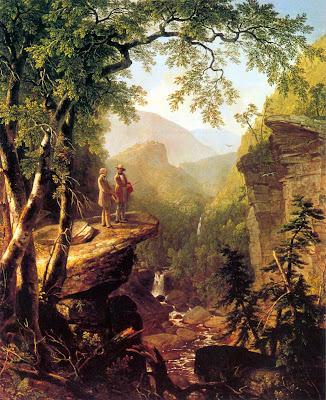The Hudson River School
Art Response
Art Response
The Hudson River School started in 1825-188 that included “landscape painters…whose vision was influenced by romanticism” (Creative Commons Attributions, 2012). There purpose was to paint by capturing nature and combining humans giving a message that they could coexist peacefully. How the school incorporated Romanticism and American nationalism was by having the people interact with nature, and seeing it as something to evolve, and become one with. What America had that Europe did not have yet was the primitive wilderness. Europe had established shops and buildings, but we still had the wonders of nature. After the paintings were viewed, people couldn’t believe that the places that were painted were real parts of the wilderness. They thought that the pictures were exaggerated in their beauty, but this simply wasn’t the case. Indeed, the pictures were accurate and not embellished, and the painters would tell the viewers those things themselves.
The picture above belongs to Asher Durand, and he titled this painting Kindred Spirits in 1849 (Wikipedia, 2012). What this painting captures is how nature is realistic. How Durand portrayed nature was that he believed that nature and human beings could live together in harmony. On the left, it shows to men standing on a small cliff that overlooks a small stream from a waterfall from the far back. They seem to be at peace having a conversation. It’s really interesting where this place is because at all angles there is something different to look at. Below there’s water and rocks, and then there’s trees of all sizes and shapes. The background has mountains that seem to go on forever, and a waterfall that seems limitless. How this painting reflects the connections with the Hudson River School and Romanticism in the American West is that the school wanted to “define a distinct vision for American art” (PBS, N.D). They wanted to show how beautiful the spontaneity was in the new land. They had “a sense of awe for its majestic natural resources and a feeling of optimism for the huge potential it held” (PBS, N.D.).
This next picture was painted by Frederic Edwin Church in 1866 (The Metropolitan Museum of Art, 2011) and was titled, Season in the Tropics. The beauty in this picture is quite amazing. The way that the mist from the rain and water captures and breaks the sunlight is almost unbelievable because of the double rainbow. Also, it looks like there are people climbing up the mountain on the bottom right hand side. They are very hard to see because of how small they are compared to the mountains, trees, and sky. How Church portrayed nature in his painting was by seeing how little in insignificant the human race is compared to the vast natural world. His perspective is very interesting because Church actually can see that people are nothing compared to nature. In fact, nature was here first before people came to the New World, so it seems that he is almost saying through his painting that the wilderness dominates us. The connection to Romanticism in the American West is that Church believes that we should make friends with Mother Earth and show her respect for the creations all around society. People should just admire the mountains, trees, water, and other elements of nature and help protect it.
The last picture was painted in 1872 by Thomas Moran called, The Grand Canyon of the Yellowstone (Coven, 2009). How Moran portrays nature seems like he had the same idea as Frederick Church. Moran has painted two individuals on the edge of a cliff on the bottom of the picture, and they are almost microscopic compared to the Grand Canyon. This picture is saying how the world is so big and vast. Just to visualize how deep and endless this canyon seems to be is overwhelming. The connection of this painting to Romanticism in the American West is that the Hudson River School believed that “if nature were untouched by the hand of man…then man could become more easily acquainted with the hand of God” (PBS, N.D.). Why the school thought of nature in this way was because in some opinions, nature is compared to a heaven on earth.
These visuals do connect with the message that the Hudson River school wanted to convey. They wanted to show that society could exist peacefully with nature and that the human race could bring harmony full circle with the wilderness and to not disrupt the splendor of the earth. However, the world is changing, and in some opinions, it is changing for the worse. Many people seem to forget the beauty of nature. Now society has motorized gadgets that seem to multiply constantly because of the growth in technology. Humans of are beginning to believe that they need some sort of high powered machinery to help them get places on water, land, mountains, etc. Edward Abbey argued from his work, Polemic: Industrial Tourism and the National Parks, “Is there any spot on earth that men have not proved accessible by the simplest means—feet and legs and heart” (page 388)? If only society could start to cease from buying unnecessary technology and keep in mind to preserve the majestic wilderness that was here so long ago. If they only realized how insignificant they are compared to the earth, perhaps they would view the wilderness in a new way. A way where they would learn to love Mother Earth back instead of adding harsh chemicals to her beauties, and see how big and beautiful nature truly is.



